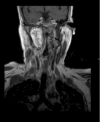Vagus Nerve Schwannoma: A Case Report and Literature Review
- PMID: 40264734
- PMCID: PMC12012257
- DOI: 10.1002/ccr3.70469
Vagus Nerve Schwannoma: A Case Report and Literature Review
Abstract
Vagus schwannomas are rare, benign masses that arise in the cervical region but can develop anywhere along the Vagus nerve. In most cases, patients present in their third to sixth decades, with neck swelling and hoarseness; herein, we discuss a case report of a 41-year-old female who presented with slurred speech and locking of her tongue and was diagnosed with Vagus schwannoma. The patient had an inability to speak properly and locking of her tongue during speech, with pain to the right side of the neck as Intermittent, prompted by turning her head to the right and shooting pain to her shoulder, which is short-lived, with a sensation of difficulty swallowing and talking that is alleviated by moving her head to a neutral position. On examination, there was mild neck stiffness, fasciculations of the tongue, and left deviation of the tongue with inability to swallow. Blood pressure was 128/70 mmHg with 42 bpm bradycardia, which was persistent on several readings, with a small right neck mass measuring 1 cm × 2 cm, non-tender on palpation. Imaging studies showed a well-defined ovoid lesion centered in the right retrostyloid parapharyngeal space measuring 3.3 × 2.1 × 3.8 cm with central T2 hyperintensities representing a nerve sheath tumor that appears stable in size and morphology. The histology report typically displayed a characteristic pattern with two distinct tissue types, Antoni A and Antoni B, with tightly packed spindle cells arranged in palisades around a central verocay body and a looser arrangement of myxoid matrix. Immunohistochemistry showed lesional cells had strong immunopositivity for S100 and were negative for CD34. Hence, the conclusion of a Vagus nerve schwannoma. Patient was sent to the radiation oncology team and was started on Cyberknife 25 Gy treatment in five fractions, which were completed and sent for re-evaluation and follow-up. There was no surgical intervention in this case due to the delicate anatomical location of the mass; hence, Cyberknife radiation was the best option for treatment. Vagus schwannomas are rare, benign masses that usually develop in the cervical region but can arise anywhere along the Vagus nerve. Patients may be asymptomatic, but in most cases, they present in their third to sixth decades; hence, they should be considered in patients with otherwise unexplained bradycardia, with a history of dysphagia, slurred speech, and cervical masses.
Keywords: Vargus nerve; benign; bradycardia; schwannoma; tumor.
© 2025 The Author(s). Clinical Case Reports published by John Wiley & Sons Ltd.
Conflict of interest statement
The authors declare no conflicts of interest.
Figures





Similar articles
-
A Rare Case of Vagus Nerve Schwannoma Presenting as a Neck Mass.Am J Case Rep. 2017 Aug 21;18:908-911. doi: 10.12659/ajcr.904084. Am J Case Rep. 2017. PMID: 28824161 Free PMC article.
-
Schwannoma of the tongue in a paediatric patient: a case report and 20-year review.Case Rep Dent. 2014;2014:780762. doi: 10.1155/2014/780762. Epub 2014 Jul 14. Case Rep Dent. 2014. PMID: 25126428 Free PMC article.
-
A Rare Case of Cervical Vagal Nerve Schwannoma in a 30-Year-Old Ethiopian Man.Int Med Case Rep J. 2023 Mar 11;16:141-151. doi: 10.2147/IMCRJ.S401858. eCollection 2023. Int Med Case Rep J. 2023. PMID: 36936185 Free PMC article.
-
Extracranial non-vestibular head and neck schwannomas: a case series with the review of literature.Braz J Otorhinolaryngol. 2022 Nov-Dec;88 Suppl 4(Suppl 4):S9-S17. doi: 10.1016/j.bjorl.2021.05.013. Epub 2021 Jun 9. Braz J Otorhinolaryngol. 2022. PMID: 34154970 Free PMC article. Review.
-
[Extracranial schwannoma of the ENT region. Review of the literature with a case report of benign schwannoma of the base of the tongue].HNO. 1997 Jun;45(6):468-71. HNO. 1997. PMID: 9324502 Review. German.
References
LinkOut - more resources
Full Text Sources

